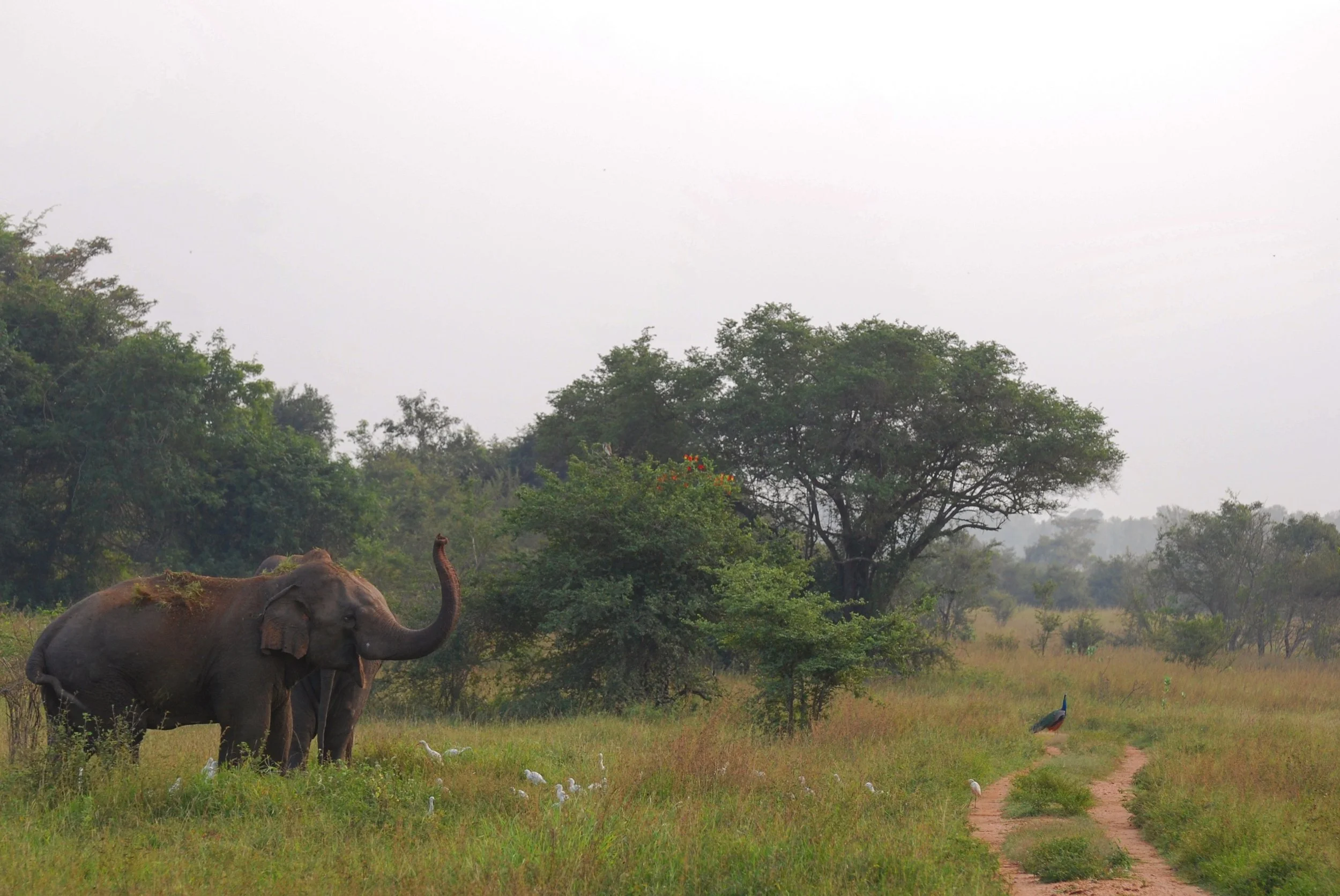A male Asian elephant in musth, distinguishable by temporal gland secretions on side of head. Minneriya National Park, Sri Lanka, July 2017. Photo: Chase LaDue.
What’s the deal with musth?
Asian elephants (Elephas maximus) are classified as endangered by IUCN with declining populations fragmented by human development. Human–elephant conflict (HEC), a major concern within elephant ranges, is most often manifested through crop-raiding with male elephants involved at disproportionately high rates. Male elephants display a unique, asynchronous sexual state called “musth.” Triggered by a testosterone surge, musth is an inter- and intrasexual reproductive signal and a driving force in elephant social organization. Musth is energetically taxing; males often turn to nutritionally rich foods in the form of human crops, thus increasing HEC. Beyond being a threat to food supplies, males are especially dangerous during musth as higher testosterone secretion leads to more aggressive behavior. Thus, local communities are more apt to turn to lethal deterrents if repeat offenders are musth males. HEC in Sri Lanka is ever more prevalent with approximately 70 humans and 250 elephants dying annually. Despite its small size, Sri Lanka has the highest elephant concentration—and second largest population—of any Asian country. Understanding the dynamics of musth in Sri Lankan elephants is of critical management importance.
Musth was described in Asian elephants in ancient times, but rigorous scientific investigation has been limited to African elephants (Loxodonta africana). Our knowledge of musth in African elephants cannot be directly applied to Asian elephants because of interspecies differences. We now understand that Asian elephants exhibit less social connectivity and more fluid core groups compared to their African counterparts. Furthermore, Asian elephants inhabit forested landscapes rather than the more open grasslands that are African elephant habitat. These factors should profoundly influence musth properties (e.g., duration, frequency, intensity) and also the ways in which musth facilitates social interactions. While there is much research on female elephant reproduction, comparatively little is known about male reproductive physiology. From ex-situ research, we know that musth is not a necessity for viable sperm production. However, in-situ musth males experience greater paternity success; therefore musth’s importance in reproduction and other interactions should not be underestimated. To learn more about the biology and behavior of musth, click here.
Sustainable ex-situ populations are important to ensure the long-term viability of the species. Many zoos actively contribute to in-situ and ex-situ Asian elephant conservation projects. Still, the North American population of Asian elephants is currently unsustainable. Efforts to reverse this trend face multiple challenges. Much has been learned about female elephant reproduction in managed populations, and concerted research to bolster breeding efforts and reduce mortality is promising. Success in these areas will increase the number of younger elephants—including males—in ex-situ facilities and further enhance reproductive opportunities to drive the population toward sustainability.
Inevitably, captive breeding will result in a larger male population. In 2017, males comprised only 22% of the North American Asian elephant population (50 males), and this proportion will approach 50% with equal sex ratios at birth. Male elephants regularly live to 60 years, further emphasizing the need to optimize male management. With enhanced breeding success, more ex-situ elephant facilities will hold males, and many will likely house multiple males. Further complicating this, ex-situ males in musth are difficult to manage because of their erratic behavior. Thus musth poses a serious danger to the people that work around males. Successful ex-situ elephant management strategies should carefully consider musth to achieve sustainability and ensure safety, but requires a greater understanding of Asian elephants to optimize the approach.
This research seeks to better characterize musth in Asian elephants, both in in-situ and ex-situ populations, developing our understanding of how male elephants interact with each other and their environments. Collaborating institutions include: George Mason University, Ringling Bros. Center for Elephant Conservation, Rajarata University of Sri Lanka, Cincinnati Zoo & Botanical Garden, Columbus Zoo and Aquarium, Denver Zoo, Fort Worth Zoo, Houston Zoo, Oklahoma City Zoo, Saint Louis Zoo, and Smithsonian’s National Zoo and Conservation Biology Institute.
learn more about this project:
Online seminar “Elephants and Musth: Science, Welfare, and Management,” given for Friends of Elephants (India), December 2022.
FUNDING SOURCES
I extend gratitude to the following organizations for funding this research. Organizations are listed alphabetically.
American Society of Mammalogists
Animal Behavior Society
Asian Elephant Support
Cosmos Club Foundation
Elephant Managers Association
The Explorers Club
Feld Entertainment, Inc. (Ringling Bros. Center for Elephant Conservation)
Fulbright US Student Program
George Mason University: Dept. of Biology, Dept. of Environmental Science and Policy, Office of the Provost, School of Integrative Studies, and Smithsonian-Mason School of Conservation
IDEA WILD
International Elephant Foundation
National Geographic Society
Oklahoma City Zoo Conservation Action Now
Saint Louis Zoo’s WildCare Institute
Virginia Academy of Science
Asian elephant in Kaudulla National Park, Sri Lanka, July 2017. Photo: Chase LaDue.



